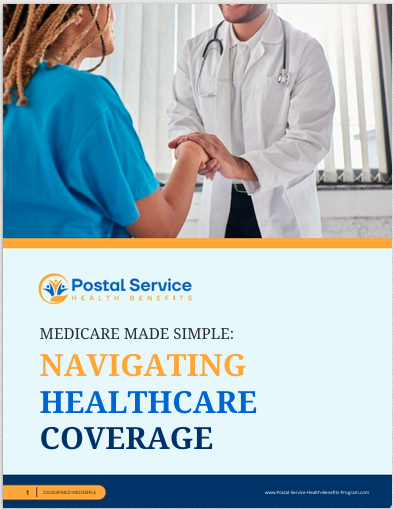Key Takeaways:
-
Medicare Part B and the Postal Service Health Benefits (PSHB) program work together, but understanding costs like premiums, deductibles, and copayments can help you budget more effectively.
-
Enrolling in Medicare Part B when first eligible can prevent late penalties and ensure continued PSHB coverage if you’re a retired postal worker.
Understanding How Medicare Part B and PSHB Work Together
If you’re a Postal Service retiree or planning for retirement, you’re probably wondering how Medicare Part B fits into your Postal Service Health Benefits (PSHB) plan. PSHB plans are tailored for postal workers and retirees, but once you become eligible for Medicare, there are important decisions to make regarding your healthcare coverage. Having a solid grasp of how these programs work together can help you avoid unnecessary expenses and coverage gaps.
1. Medicare Part B Enrollment is Often Required for PSHB Retirees
Starting in 2025, most Medicare-eligible postal retirees must enroll in Medicare Part B to keep their PSHB coverage. If you retired before January 1, 2025, you may be exempt from this requirement, but for newer retirees, skipping Part B could mean losing PSHB benefits.
Medicare Part B covers outpatient services like doctor visits, preventive care, and medical equipment, complementing the hospital coverage from Medicare Part A. Since PSHB plans are designed to coordinate with Medicare, enrolling in Part B ensures your coverage remains intact. It also means your PSHB plan acts as secondary coverage, potentially covering costs that Medicare does not, such as certain copayments or additional services.
2. Understanding the Costs: Premiums, Deductibles, and Copays
Medicare Part B comes with a monthly premium, which varies based on your income. In 2025, the standard Part B premium is $185 per month, though higher-income individuals may pay more due to Income-Related Monthly Adjustment Amounts (IRMAA). Your PSHB plan may offer incentives or reimbursements to help offset this cost, but these benefits vary by plan.
Beyond premiums, Medicare Part B also has:
-
A deductible of $257 per year.
-
Coinsurance of 20% for most outpatient services after meeting the deductible.
-
Additional out-of-pocket expenses, including copayments for services not fully covered.
Your PSHB plan may cover some of these costs, such as reduced copayments or waived deductibles. However, this depends on the plan you choose, so reviewing your options carefully is essential.
3. Coordination Between Medicare Part B and PSHB Can Reduce Out-of-Pocket Costs
One major benefit of having both Medicare Part B and a PSHB plan is cost-sharing. When you have both, Medicare generally pays first (as the primary insurer), and your PSHB plan picks up additional costs. This coordination can lead to lower out-of-pocket expenses, as:
-
Medicare covers 80% of most outpatient services after the deductible.
-
Your PSHB plan may cover some or all of the remaining 20%.
-
Some PSHB plans offer prescription drug benefits, reducing medication costs.
Without Part B, you might end up paying more for certain outpatient services, as PSHB plans typically assume retirees are enrolled in Medicare. This could leave you responsible for unexpected expenses that Medicare would otherwise cover.
4. Late Enrollment Penalties Can Be Costly
If you don’t sign up for Medicare Part B when you’re first eligible, you might face lifetime penalties. Medicare’s standard enrollment window starts three months before you turn 65 and extends until three months after your birthday month. If you miss this period, you may have to wait until the next General Enrollment Period (January 1 – March 31 each year) and could face penalties, including:
-
A 10% increase in premiums for every 12-month period you delay enrollment.
-
Higher overall healthcare costs due to gaps in coverage.
-
Possible limitations in PSHB benefits due to lack of Medicare Part B enrollment.
Since PSHB retirees must enroll in Part B to maintain coverage, delaying enrollment could mean losing access to your PSHB benefits. The penalty does not go away, which means the longer you wait, the higher your Part B costs will be for the rest of your life.
5. Making an Informed Decision: Reviewing Your PSHB Options Annually
Medicare and PSHB plans can change annually, affecting costs and coverage. Each year, during Medicare Open Enrollment (October 15 – December 7) and PSHB Open Season (typically mid-November to mid-December), you have the chance to review and adjust your coverage. This is the best time to:
-
Compare available PSHB plans to see which works best alongside Medicare.
-
Check for updates in premiums, deductibles, and coverage benefits.
-
Ensure your preferred doctors and services remain covered under both plans.
-
Look for cost-saving opportunities such as reduced copayments and enhanced benefits.
Even if you’re already enrolled in Medicare and PSHB, reviewing your options annually can help you find the best balance between coverage and cost. Failing to review changes could result in unexpected increases in premiums or reductions in covered services.
Making the Most of Your Medicare and PSHB Coverage
By enrolling in Medicare Part B on time and selecting the right PSHB plan, you can ensure lower out-of-pocket expenses and continuous coverage. Healthcare decisions can feel overwhelming, but taking the time to understand your options now can prevent costly mistakes later. Planning ahead and seeking guidance when needed can help you make informed choices that align with your health and financial needs.
If you’re unsure about your choices, speaking with a licensed agent listed on this website can provide personalized guidance to help you navigate your Medicare and PSHB benefits. These professionals can offer insights into cost-saving strategies and help you optimize your benefits for the best coverage.






